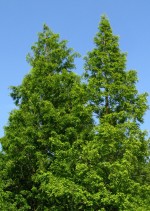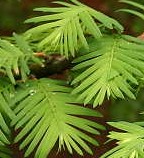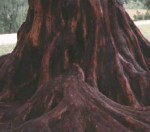 This deciduous conifer was described from fossil evidence in 1941 and was thought to be extinct until 1944 when a few trees were found in central China. Since then seeds have been distributed by the Arnold Arboretum and the tree is now widely planted in Europe and North America. Although the tree can reach a height of 150 feet in its natural habitat, in cultivation it usually grows to about 100 feet. It grows very rapidly, 3-4’ per year, and becomes broad and conical with a uniform orderly habit. The fern-like leaves are ¾” long and are attached to deciduous green stems. They are bright green when they first emerge becoming darker as they mature, and turning yellow-brown to pink, apricot and finally copper-brown in the fall. Clusters of male and solitary female cones are produced on the same tree but are not ornamentally important. The reddish brown bark develops fissures as it matures and peels in long strips. The trunk becomes braided and fluted with age and develops buttresses. Because of its size, dawn redwood is best planted in large spaces such as parks or golf courses, and works well as a specimen, a shade tree, a screen, or planted in groves.
This deciduous conifer was described from fossil evidence in 1941 and was thought to be extinct until 1944 when a few trees were found in central China. Since then seeds have been distributed by the Arnold Arboretum and the tree is now widely planted in Europe and North America. Although the tree can reach a height of 150 feet in its natural habitat, in cultivation it usually grows to about 100 feet. It grows very rapidly, 3-4’ per year, and becomes broad and conical with a uniform orderly habit. The fern-like leaves are ¾” long and are attached to deciduous green stems. They are bright green when they first emerge becoming darker as they mature, and turning yellow-brown to pink, apricot and finally copper-brown in the fall. Clusters of male and solitary female cones are produced on the same tree but are not ornamentally important. The reddish brown bark develops fissures as it matures and peels in long strips. The trunk becomes braided and fluted with age and develops buttresses. Because of its size, dawn redwood is best planted in large spaces such as parks or golf courses, and works well as a specimen, a shade tree, a screen, or planted in groves.
Just a side note: In the early 1960’s the head gardener took cuttings from the original Arnold Arboretum trees and planted them in our New Jersey nursery. Today, trees from that original crop are approaching 100′ tall and are truly “forest trees”. The 10 or 12 trees that were not sold and left in the nursery now form a magnificent grove of Metasquoia. Their spreading fern-like dark green foliage and the noises even the slightest breeze creates makes for a very unique spot in the nursery; it is very similar to a redwood forest.
Type: Deciduous confer tree
 Outstanding Features: Shape, size
Outstanding Features: Shape, size
Form: Conical, uniform, orderly, upright; horizontal branching
Growth Rate: Rapid (3-4’/year)
Bloom: Clusters of male cones and solitary female cones are produced on the same tree
Size: 100-150’ H x 25-40’ W
Light: Full sun
Soil: Average, moist, well-drained, lightly acidic
 Hardiness: Zones 4-8
Hardiness: Zones 4-8
Care: Avoid planting in frost pockets because early fall frosts may kill late growth
Pests and Diseases: Japanese beetles; spider mites in dry conditions
Propagation: Seed (with stratification); softwood and hardwood cuttings
Outstanding Selections:
-
‘Sheridan Spire’ (narrow, compact, ascending limbs)
‘Ogon’ (slower growing, bright yellow-green foliage, aka ‘Gold Rush’)
‘Jack Frost’ (white and green variegated)
